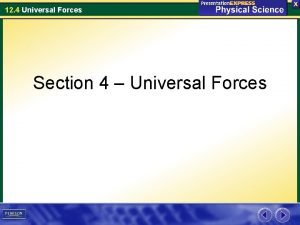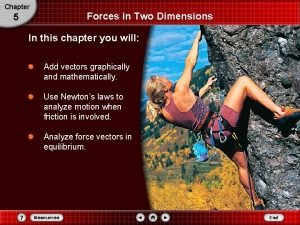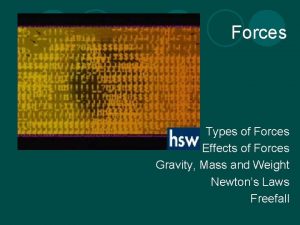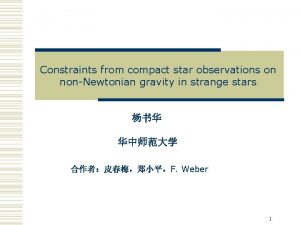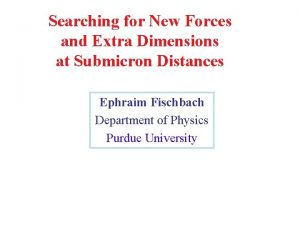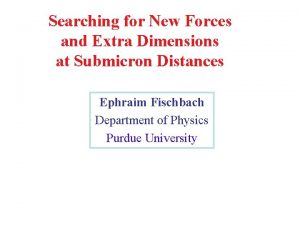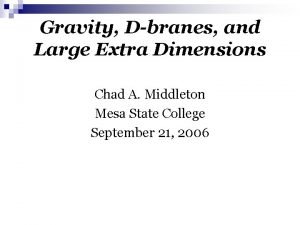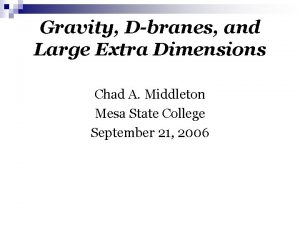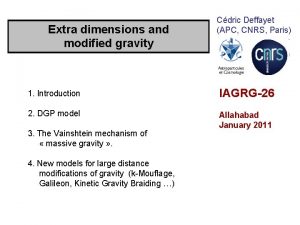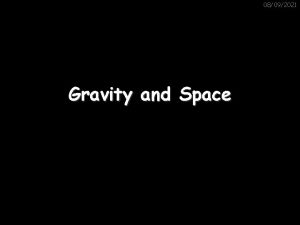Extra Dimensions New Forces and NonNewtonian Gravity XXXVIth













- Slides: 13

Extra Dimensions, New Forces, and Non-Newtonian Gravity XXXVIth Recontres de Moriond Very High Energy Phenomena in the Universe 22 January 2001 Ephraim Fischbach Department of Physics Purdue University, West Lafayette, IN 47907

Overview • Was Newton Really Right? – Tests of 1/r 2 law – Tests of the equivalence principle – Importance of scale • Motivations for Non-Newtonian Gravity – New light quanta new forces – Unification and extra dimensions • Experimental Tests – Problems with short-distance experiments – The “iso-electronic” effect – The Purdue AFM experiment • Outlook Purdue University Department of Physics 22 January 2001

Summary of Newtonian Gravity • Newtonian Gravity • Non-Newtonian Gravity m 1 r m 2 doesn’t vary as 1/r 2 * a) independent of the nature of m 1 (Equivalence Principle) b) varies as 1/r 2 Purdue University Department of Physics not independent of 1 or 2 * * Evidence for either of these would point to a new fundamental force in nature. 22 January 2001

Summary of Newtonian Gravity m 1 r m 2 a) independent of the nature of m 1 (Equivalence Principle) b) varies as 1/r 2 Purdue University Department of Physics 22 January 2001

Non-Newtonian Gravity m 1 r m 2 doesn’t vary as 1/r 2 * not independent of 1 or 2 * * Evidence for either of these would point to a new fundamental force in nature. Purdue University Department of Physics 22 January 2001

Mini-Review #1 • The existence of ultra-light particles can produced longrange fields which behave somewhat like gravity • The presence of such fields would show up as apparent deviations from the predictions of Newtonian gravity 1/r 2 violations equivalence principle violations • To search for such violations, experiments must be carried out over many distance scales • Newtonian gravity is OK down to ~ 1 mm. Below ~ 1 mm we know relatively little about the behavior of Newtonian gravity Purdue University Department of Physics 22 January 2001

Theory of New Forces A new force can arise from the exchange of a light quantum with appropriate properties scalar(JP = 0+) m vector (JP = 1 -) p, e, n, (p , …) scalar p, e, n, (p , …) l = Range = /mc Bulk Matter Purdue University Department of Physics if m = 10 -9 e. V/c 2 l = 200 m 22 January 2001

Long-Range Forces Over Sub-mm Scales • Various mechanisms lead to potentials with and inverse power law behavior • Also: String Theory Models … • Such forces can best be detected in experiments where the interacting bodies are very close to each other, as in the Casimir Effect • Problems n=2 2 -photon exchange; 2 -scalar exchange n=3 2 -pseudoscalar exchange n=4 n=5 nn-exchange; 2 -axion exchange Purdue University Department of Physics – How to separate out the new forces from the known electromagnetic effects – Forces are intrinsically small – V(r) 1/r 22 January 2001

Numerical Estimates • It is convenient to introduce an energy scale set by the usual Newtonian constant G 4. This is the Plank mass MPl M 4 MPl = ( c/G 4)1/2 = 2. 18 10 -5 g = 1. 22 1019 Ge. V/c 2 • In natural units ( = c = 1) M 42 = 1/G 4 • The analog of the Plank mass in higher dimensions is called M 4+n • When expressed in terms of M 4 and M 4+n the previous result G 4 = G 5/4 R generalizes to • This forms the basis for current experiments Purdue University Department of Physics 22 January 2001

How Big is M 4+n? How big is n? 1) The usual Plank mass M 4 and the associated length scale /M 4 c 10 -33 cm are the scales at which gravitational interactions become comparable in strength to other interactions, and hence can be unified with these interactions 2) It would be nice if this happened at a smaller energy scale bigger length scale. A natural choice is ~ 1 Te. V = 1012 e. V where supersymmetry breaks down 3) This can happen in some string theories with extra spatial dimensions if ordinary matter is confined to 3 -dimensional walls (“branes”), and only gravity propagates in the extra dimensions Purdue University Department of Physics 22 January 2001

How Big is M 4+n? How big is n? 4) In such theories M 4+n 1 Te. V by assumption We then solve: (1019 Ge. V)2 (1 Te. V)n+2 n = 1 R(1) 2 1015 cm n = 2 R(2) 0. 2 = 2 mm n = 3 R(3) 9 10 -7 cm Purdue University Department of Physics NO GOOD !! OK !! ? ? 22 January 2001

Mini-Review #2 • The gravitational force in a space with n extra spatial dimensions varies as • To avoid a conflict with known gravity tests one must arrange things such that any new force law show up only at very short scales. This can be achieved using additional compact spatial dimensions. • The size of R(n) of these extra dimensions is governed by the relation Purdue University Department of Physics 22 January 2001

Motivation for Short-Distance Gravity Selected References: N. Arkani-Hamed, S. Dimopoulos, & G. Dvali, Phys. Rev. D 59, 086004 (1999) A. Kehegias and K. Sfetsos, Phys. Lett. B 472, 39 (2000) L. Randall and R. Sundrum, Phys. Rev. Lett. 83, 4690 (1999) J. Garriga and T. Tanaka, Phys. Rev. Lett. 84, 2778 (2000) Purdue University Department of Physics 22 January 2001
 Gravity for dummies and dummies for gravity equations
Gravity for dummies and dummies for gravity equations The universal forces
The universal forces Example for like parallel force
Example for like parallel force Contact and noncontact forces
Contact and noncontact forces Net force
Net force Destructive process examples
Destructive process examples Forces in 2 dimensions worksheet answers
Forces in 2 dimensions worksheet answers The forces shown above are
The forces shown above are Intermolecular and intramolecular forces
Intermolecular and intramolecular forces Intermolecular forces ranked
Intermolecular forces ranked Covalent bond intermolecular forces
Covalent bond intermolecular forces Marketing for the new realities
Marketing for the new realities New market realities
New market realities Count that day
Count that day

